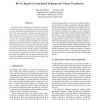Free Online Productivity Tools
i2Speak
i2Symbol
i2OCR
iTex2Img
iWeb2Print
iWeb2Shot
i2Type
iPdf2Split
iPdf2Merge
i2Bopomofo
i2Arabic
i2Style
i2Image
i2PDF
iLatex2Rtf
Sci2ools
PG
2003
IEEE
2003
IEEE
RGVis: Region Growing Based Techniques for Volume Visualization
Interactive data visualization is inherently an iterative trial-and-error process searching for an ideal set of parameters for classifying and rendering features of interest in the data. This paper presents 3-d region growing based techniques that can assist the users to locate and define features of interest in volume data more quickly and more accurately. One technique employs partial region growing to generate a 2-d transfer function that effectively reveals the full features of interest. The other technique uses the result of full region growing to systematically construct a boundary surface for the extracted features. The resulting polygonal representation of the boundary surface can facilitate comparison, measurement, and simulation. A visual assessment method is suggested by using the extracted volume and surface information. These techniques either shorten or completely eliminate the typical trial-and-error step in the process of interactive data exploration.
| Added | 05 Jul 2010 |
| Updated | 05 Jul 2010 |
| Type | Conference |
| Year | 2003 |
| Where | PG |
| Authors | Runzhen Huang, Kwan-Liu Ma |
Comments (0)

